| Article ID | Journal | Published Year | Pages | File Type |
|---|---|---|---|---|
| 273193 | Fusion Engineering and Design | 2007 | 10 Pages |
Metal mirrors are planned for optical diagnostic systems of ITER. However, erosion, deposition and particle implantation can change the performance of mirrors. Mirrors made from the single crystal (SC) materials are among the main candidates for use in ITER diagnostic systems operating under erosion-dominated conditions. Laboratory tests have confirmed good optical performance of SC mirrors under erosion, but the dedicated direct comparative test in tokamak environment was missing.Such a direct test was performed in TEXTOR. Single crystal molybdenum, tungsten and polycrystalline (PC) molybdenum mirrors were exposed under the same conditions in the SOL plasma of TEXTOR. Surface and optical properties of mirrors were characterized before and after exposure. Before exposure glow discharge cleaning in hydrogen restored the reflectivity of mirrors oxidized during storage on air.No significant changes in total reflectivity were observed for all mirrors after exposure. Drastic increase of diffuse reflectivity was measured for PC Mo mirror, no change for a SC one. Thus, specular reflectivity of single crystal is higher than of polycrystalline one. The most affected wavelength range is 250–1000 nm, no significant change of reflectivity was noticed in the range 1000–2000 nm. Negligible effect of the exposure on polarization characteristics was observed.
